Last Updated on April 4, 2024
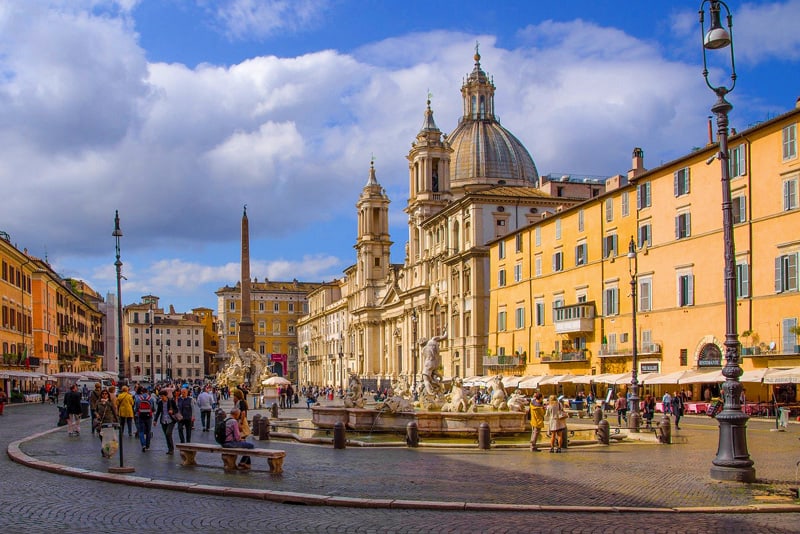
By Jim Ferri
I love the Piazza Navona, one of the most beautiful and famous squares in the center of Rome.
The Piazza Navona, you see, is unlike any other piazza in the city, perhaps even the country.
First of all, it doesn’t look like any ordinary piazza. It isn’t square or rectangular like others, but instead oblong. That’s because a 30,000-seat stadium, about half the size of the Colosseum, was built there in 86 AD. It was used for foot races, chariot and horse races, and other events. Occasionally, it was even flooded to hold naval games.
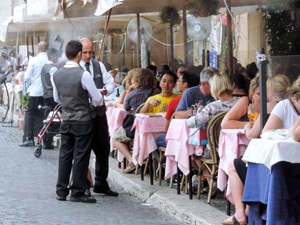
In ancient Rome, it was one of the places to spend time. And today’s Piazza Navona now sits atop it.
Although the stadium is long gone, it’s still one of the places to spend time. Come to Rome, head for Navona and you’ll find there’s always something happening in the piazza. In fact, if you’re taking a self-guided walking tour of Rome, time it to have lunch or evening drinks here.
To some, Navona is the social center of modern Rome; for me, it’s the city’s heart. In fact, I find it almost magical. Moreover, it’s excellent for people-watching without the chaos and crowds you find at the Fontana di Trevi, the Colosseum, the Vatican museum.
Above all, any day or night it can be more theatrical than any other place in the capital. It is, as the Sunday Times of London once described it, “pure, ravishing theatre.”
When you’re in Rome, one of the best places in Italy to visit, don’t miss this theater. In addition to great people-watching, you’ll likely enjoy the following, as well.
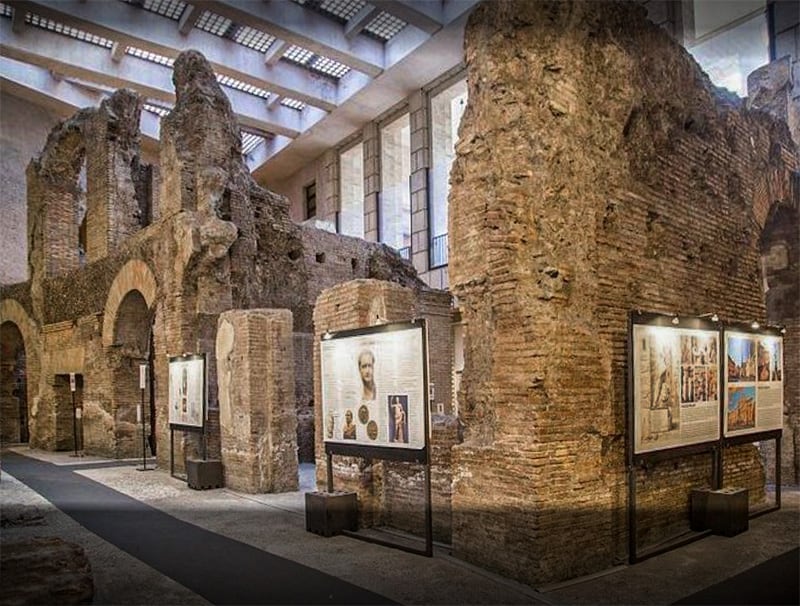
A UNESCO World Heritage Site Under the Piazza Navona
The original stadium beneath the Piazza Navona was built by the Roman Emperor Titus. Although excavations have unearthed remnants of it, they are mainly the area about the perimeter of the stadium. However, on Piazza di Tor Sanguigna at the northern end of the Piazza Navona, you can see remnants of the original stadium. It’s now a UNESCO World Heritage Site.
About 15 feet below street level, Stadio Domiziano was first opened to the public in 2014. This archaeological area is all that remains of the only masonry stadium known in Roman history. You can take tours of the excavations, which are about 45 minutes long.
If You Go:
Stadio Domiziano
Via di Tor Sanguigna 3
[email protected]
Tel: +39 06.68805311
Open: every day from 10am – 7pm. On Saturdays from 10am – 8pm.
Admission: standard: € 8,50 / 12-17 years old and over 65 € 6,50 / 8-11 years old € 4,50 / children up to 7 years old free. Audio guides are provided with these tickets.
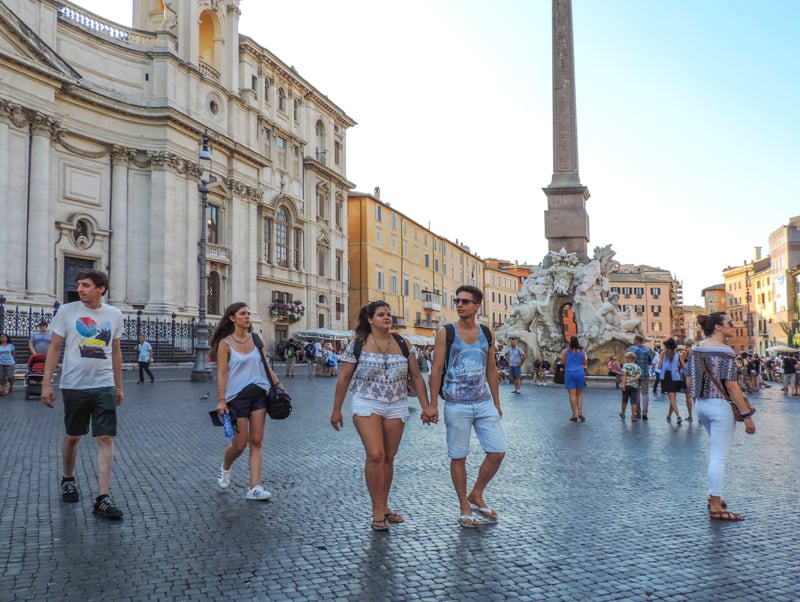
A (Very) Short History of the Piazza Navona
After the fall of the Roman Empire, houses were built atop the seating areas of the stadium. The oblong field, however, remained free of buildings. Then, during the Middle Ages, people pilfered the site, much as they did to the Colosseum, leaving only remnants. Pre-cut stone was a valuable commodity at the time.
During the Renaissance, the area was leveled, and Rome’s city market was moved there from the Campidoglio, the square (the first in Rome, in fact) designed by Michelangelo on one of the Seven Hills of Rome. That move made Piazza Navona the primary outdoor fruit and vegetable market of the city. In 1869, though, the market was moved to Campo Dei Fiori, its present location.
Beginning in the 1400s, with the market occupying the space of the former stadium, Piazza Navona became a public space. During the mid-16th century, Pope Gregory XIII built three fountains in the piazza, although they were not masterpieces we see there today.
In the 1600s, Pope Urban VIII began constructing monuments and buildings all about Rome to establish his legacy. His successor, Pope Innocent X, then continued the construction spree to ensure his own legacy. During this time, numerous Baroque buildings began to populate the area in and around the piazza.
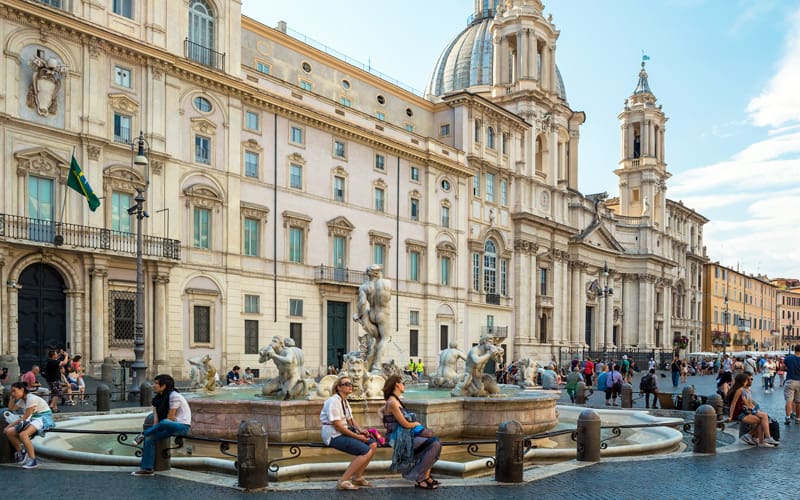
A Pope, a Palace and a Place of Worship
As part of his 17th-century-construction campaign, Pope Innocent X built an opulent Baroque palace. On the southwest corner of the piazza, it’s name is Palazzo Pamphilj in honor of Innocent’s family. For the past 100 years, however, it has been the home of the Brazilian Embassy in Italy.
Of course, at that time in Catholic Italy many palaces required a “family chapel.” The Baroque chapel Innocent built is the church of Sant’Agnese in Agone, named for Saint Agnes, an early Christian saint martyred in the old stadium on the current site.
One of the beautiful Baroque buildings on the piazza, the church is located midway across from the Fountain of the Four Rivers.
Inside Sant’Agnese in Agone today, you’ll find frescoes, sculptures, and a shrine containing the saint’s skull. Innocent X is also entombed there. In addition, small music concerts – from chamber music to Baroque works – are occasionally held in the Borromini Sacristy of the church.
If You Go:
Sant’Agnese in Agone
Via di Santa Maria dell’Anima, 30/A
[email protected]
Tel: +390668192134
Admission: free
Note: the church is open weekdays, except Monday, 9:00am to 7:00pm (closed from 1:00 pm to 3:00 pm); open Saturday and Sunday 9:00am to 8:00pm (closed from 1:00 pm to 3:00 pm)
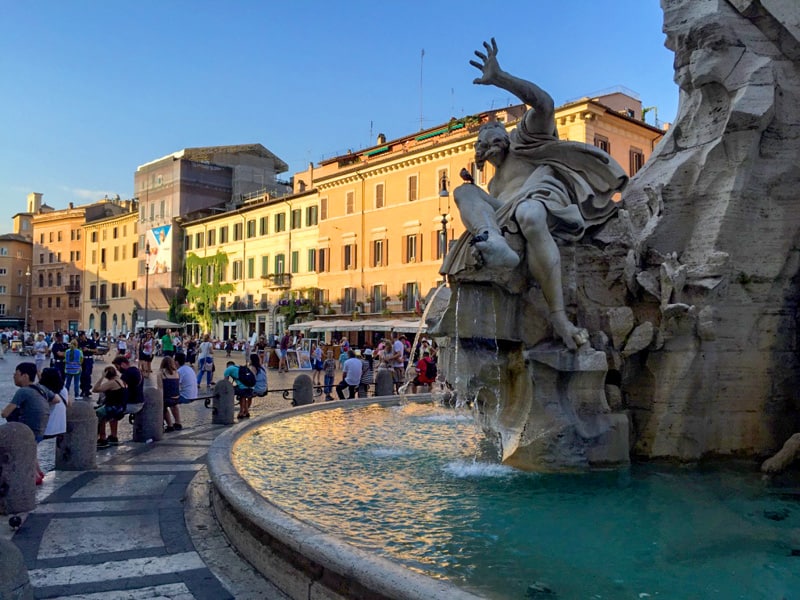
Fabulous Fountains of the Piazza Navona
Innocent also began the practice of flooding the piazza every Saturday and Sunday in August, allowing people to frolic in the water during the late summer heat. Engineers were able to flood the plaza merely by plugging the drainage system of its three fountains.
Today, as you might expect, the Piazza Navona’s three fountains are renown in Rome. The most famous and most beautiful is Gian Lorenzo Bernini’s magnificent Fontana dei Quattro Fiumi (“Fountain of the Four Rivers”). In the center of the piazza, each of the four figures on the fountain represents one of the four great rivers of the world at the time of construction (the Danube, the Nile, the Ganges, and the Rio de la Plata).
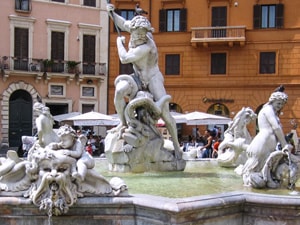
In addition, crowning the fountain is an obelisk commissioned by Emperor Domitian, builder of the original stadium. The 54-foot (16m) obelisk was brought to the piazza from the Circus of Maxentius located on the Via Appia.
The other two fountains – the Fontana di Nettuno and the Fontana del Moro – were designed by Giacomo della Porta,an apprentice of Michelangelo.
At the southern end of the piazza, Fontana del Moro has a Moor, surrounded by four Titans, wrestling a dolphin. Although the original fountain was sculpted in 1575, Bernini added the statue of the Moor about 100 years later.
At the piazza’s northern end, Fontana di Nettuno was sculpted a year before “the Moor” fountain. It shows Neptune surrounded by cherubs and fighting an octopus. All were added in the 19th century by sculptors Antonio Della Bitta (the octopus) and Gregorio Zappalà (the cherubs) to make the fountain more symmetrical with the Fontana del Moro.
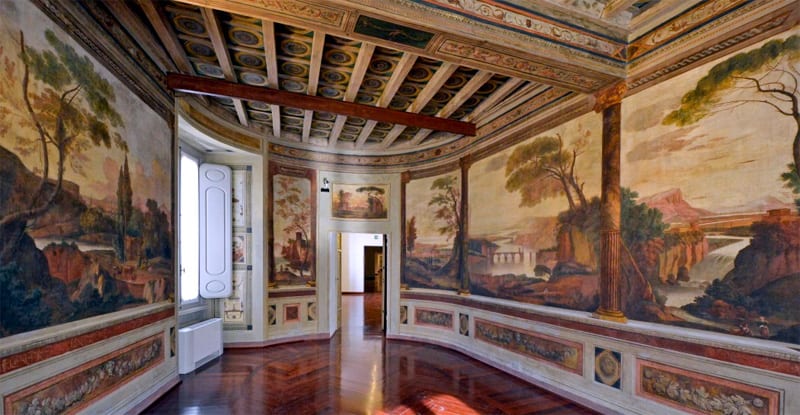
Palazzo Braschi / Museum of Rome
At the southern end of the Piazza Navona, adjacent to the Palazzo Pamphilj, is the Palazzo Braschi, a neoclassical residence. Although originally built for a nephew of a Pope, it now houses special exhibitions of the Museum of Rome. Through its collection of paintings and other works of art, the museum relates the history of Rome through the centuries.
Works in the collection are by Italian and foreign artists active in Rome from the 17th to 20th centuries. There are more than 100,000 of them in its collection, ranging from portraits of popes to views of Rome. The collection also includes terracotta sketches by Gian Lorenzo Bernini, the sculptor of “Fountain of the Four Rivers” in the Piazza Navona.
In addition to its works of art, the museum’s windows also provide a beautiful view of the Piazza Navona.
If You Go:
Museo di Roma
Piazza di San Pantaleo, 10
Piazza Navona, 2
[email protected]
Tel: +39060608
Open: Tuesday to Sunday: 10:00am – 7:00pm
Admission: varies – see http://www.museodiroma.it/en/biglietti-e-prenotazioni/tickets-1
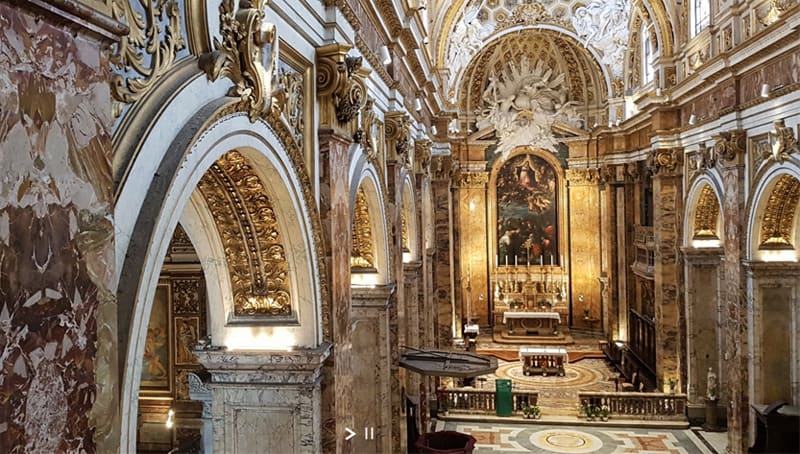
Church of St. Louis of the French
Though not on the Piazza Navona, only a block away from the piazza’s northern end is San Luigi dei Francesi. As a matter of fact, it’s only a two-minute walk from the piazza.
The Church of St. Louis of the French is France’s national church in Rome. If you visit, you’ll likely follow other visitors making a bee-line to the church’s three significant Caravaggio works. You’ll find them in the last chapel on the left.
If You Go:
San Luigi dei Francesi
Piazza di S. Luigi de’ Francesi
(take Via del Salvatore to Via della Dogana Vecchia)
Tel: +3906688271
Open: Monday – Friday 9:30am – 12:45pm; 2:30pm – 6:30pm / Saturday and Sunday 9:30am – 12:15pm; 2:30pm – 6:30pm
Note: An English-language tour of the church is available on your mobile phone. When entering the church, you’ll find a QR code, or you may manually look for this address: https://appli.lespierresparlent.com/#/lpp/2269, to reach the audioguide.
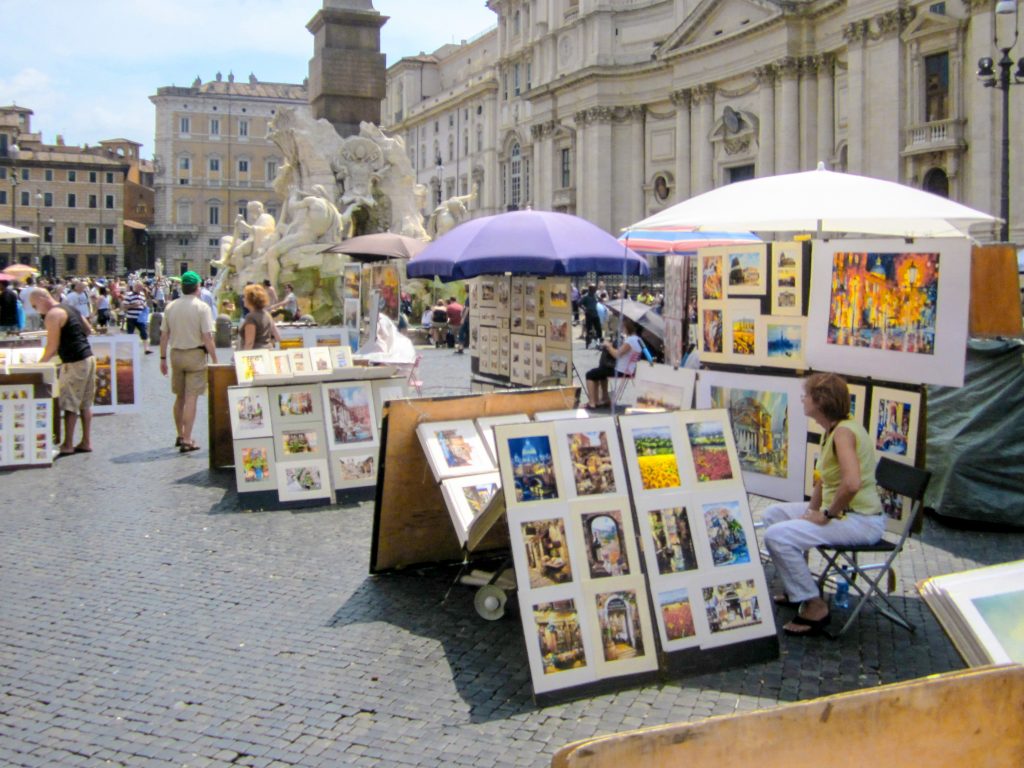
Artists Eking Out a Living on Piazza Navona
In addition to tourists here, you also find plenty of artists presenting works for sale. Their canvasses run the gamut of large portraits of screen idols both past and present, to more bucolic scenes of the Italian countryside and popular urban tourist places. Some you wouldn’t put in the bottom of a birdcage, but others you’ll find quite pleasing.
I first succumbed to the charms of the Piazza Navona several years ago. At that time my wife and I bought some watercolors from one of the artists, an architect from Syria.
He had moved to Rome but couldn’t find work, so he turned to his love of painting. We bought five small watercolors of Roman scenes from him, which we hung in a corner of our home.
Years later, as we were strolling about the piazza, we came across him once again. When we told him we had bought some of his works years earlier, he exclaimed in mock excitement, “I’m famous!” Following a short chat, we wound up buying three more of his works.
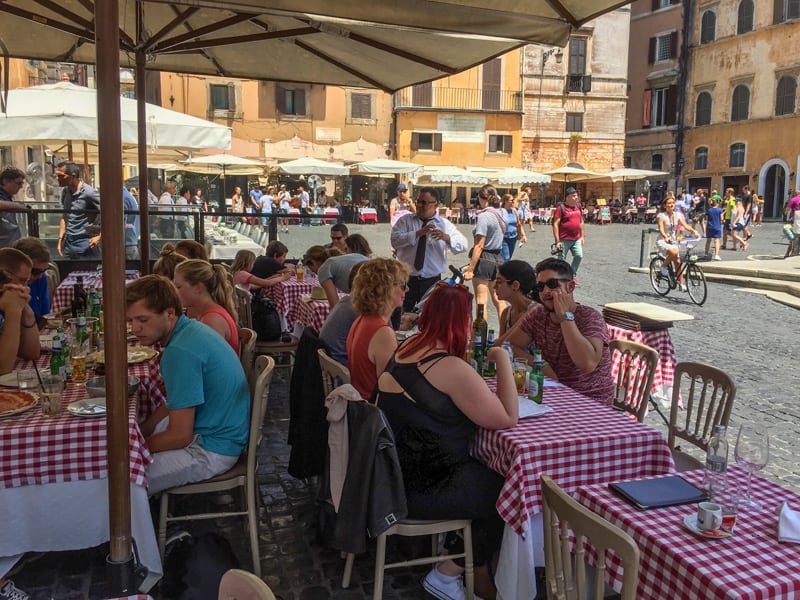
On the Piazza Navona, Save Time to Eat, Drink, and Enjoy Gelato
Besides perusing the art for sale in the piazza, we always enjoy another activity in the Piazza Navona…searching for a ringside table in one of the little cafes. They’re the perfect place to sit and have lunch, or to sip an espresso or an early evening drink and just overdose on people watching.
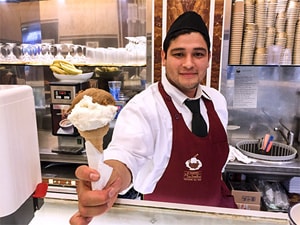
You’ll find no lack of ristorantes and cafes in the area from which to choose. The drinks and food aren’t cheap, of course, but they’re worth the extra euros for the experience.
But instead of me recommending any best restaurants in the area – since “the best” is constantly in flux due to changing chefs and management – I recommend you consult TripAdvisor’s Restaurants near Piazza Navona. Since its reviews are continually changing, it will give you the best overview of the bouillabaisse of restaurants about the piazza.
One place I will recommend, however, is the well-known Tre Scalini at Piazza Navona 28 for an incredible tartufo. To understand why, see In Search of the Best Gelato in Rome. Then, make sure to put it on your Rome to-do list.
Buon appetito!
And above all, forget the calories. This is Italy, after all…
If You Go:
Italian National Tourist Board
686 Park Avenue – 3rd Floor
New York, NY 10065
[email protected]
10850 Wilshire Blvd. Suite 575
Los Angeles, CA 90024
[email protected]
365 Bay Street – Suite 503
Toronto (Ontario) M5H 2V1
[email protected]
Editor’s Note: you may also enjoy… Top 10 Things To Do in Rome, Where to Find 8 Fascinating Walks in Rome and, 24 Hours in Rome (Video)

Very educational. Color me impressed…
As always Jim, you bring it into our homes as if we where there already. Although Italy is still battling with viruses as is rest of the world, Italy has put some travel restrictions on Americans not vaccinated&vaccinated regarding traveling within their country. Clearly understandable, but, they have allowed their own Italian citizens to wonder the country with or without being vaccinated, does this make any sense? Then again so do we.
Seeing how Italy was one of the First Nations to be hit severely by Covid and now delta viruses you would think they’d apply same restrictions to those citizens of Italy not vaccinated.
We have missed not being able to visit Italy and friends there going on 3 years now do to health issues that now under control and pandemic. Until there is more proof vaccines are 100% effective in protecting and out breaks calm down just sit on sidelines waiting for opportunity to resume traveling once again. Thanks again for great travel information from all parts of the world.
Hi Frank, Thanks for your comments. I think the entire world seems to be helpless in this pandemic since politicians don’t “follow the science”. Nations need to impose the same regulations on their own citizens that they impose upon visitors.
Loved this piece, Jim. Navona is our all time favorite spot in Rome. The last time we were there, we got to go Underground and it was very cool. I think Carrie brings her Latin students underground there!
Hi Pat, Navona is a wonderful place that is so close to so many other places. Every time I go back to Rome – which is fairly often, at least pre-pandemic – I always tried to visit Navona again and have lunch in one of the cafes. It really is great theater.